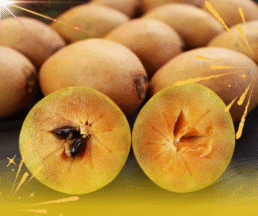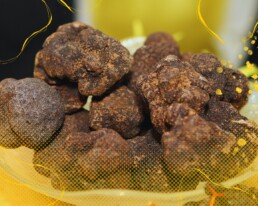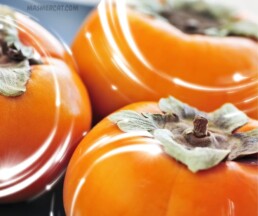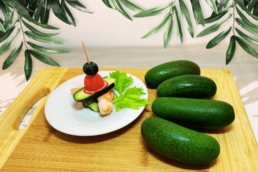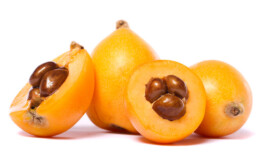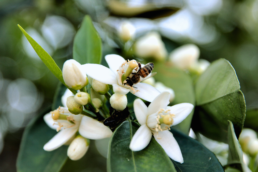Tree Bread (Jackfruit): The fruit that tastes like all fruits
As is customary, we'll talk about another fruit, this time an exotic one called Jackfruit (Yaca or Jaca), as we recently had the opportunity to try it in Mexico, where we witnessed its cutting and pulp extraction, which, by the way, is not easy at all. You need to keep some tips in mind if you don't want to end up with sticky hands and to know when it's ripe, otherwise, it will taste very acidic.
With a rough, green, and large appearance, the inside reveals the fibrous flesh surrounding the orange-colored arils when they are ready to eat. It has its own unique flavor but is somewhat reminiscent of papaya, mango, and pineapple, which is why some call it the "fruit-flavored fruit." Like most fruits, the riper it is, the sweeter it is, but the smell can be strong, even unpleasant for some sensitive noses. The fruit's ripeness can be recognized just by touching its skin; if it yields slightly, it is ready. It may also show brown tones on the skin, but the secret is not to let it pass that point, or the taste will no longer be optimal.
Its Origin
Jackfruit (Artocarpus heterophyllus) is a tropical fruit, native to South Asia and Southeast Asia; botanical and ethnobotanical evidence places it in the region between Southern India (Western Ghats) and Southeast Asia, where various varieties exist. It is currently found in several Latin American countries such as: Brazil, Venezuela, Ecuador, Peru, Colombia, Mexico, Guatemala, Nicaragua, and the Caribbean. Generally, it thrives in any Latin American country with a warm and humid tropical climate, from sea level up to about 1500 meters of altitude.
This fruit is known by various names such as jaca, nanca, langcá, panpén, or tree bread, among others.
How to Consume It and Care Tips for Peeling / Cutting (Practical Tips)
Regarding consumption: traditionally, in Asia, it is eaten both ripe (the sweet pulp) and green (cooked), and the seeds are also consumed, either boiled or roasted.
- For ripe Jackfruit: Eat the "arils" (the sweet segments) raw or in smoothies, ice creams, and desserts.
- For green (unripe) Jackfruit: It is used cooked in stews, stir-fries, curries, or as a meat substitute in tacos, burgers, or pulled-jackfruit.
- Seeds: They are boiled, roasted, or added to stews — they are edible and rich in starch.
- Trick for peeling without a mess: Smear the knife and your hands with neutral oil (this prevents the sticky sap from complicating the cutting). Cut the fruit lengthwise into quarters or halves, separate the rind, extract the woody core, and separate the arils by pulling away the fibrous tissue; remove the membrane surrounding the seeds. Use gloves if you prefer. These practical recommendations reduce stickiness and allow you to work safely. For more details, watch our video on our social media channels (RRSS).
Demand in Europe and Western markets has grown in recent years, driven by the plant-based trend and its use as a shredded meat substitute (a "pulled" texture). Market reports indicate sustained growth and increased presence in specialized supermarkets, vegan restaurants, and processed products.
Properties and Health Benefits
Jackfruit is nutritious: it provides carbohydrates, fiber, Vitamin C, potassium, and, notably, its protein content (2g) is high for a fruit. It also contains bioactive compounds (flavonoids, lignans) with antioxidant and anti-inflammatory potential. Studies reviewed in scientific literature list it as an interesting source of micronutrients and phytochemicals.
| Nutritional Component | Amount (per 100 g) | Key Contribution |
|---|---|---|
| Energy | 95 kcal | Medium caloric intake |
| Carbohydrates | 23 g | Main energy source |
| Sugars | 19 g | Responsible for its sweetness |
| Dietary Fiber | 1,5 - 2,5 g | Aids digestive health |
| Protein | 1,7 - 2,0 g | High for a fruit |
| Total Fats | 0,6 g | Very low fat content |
| Vitamin C | 10 - 14 mg | Potent antioxidant |
| Potassium (K) | 400 - 450 mg | Heart health and blood pressure |
| Magnesium (Mg) | 25 - 30 mg | muscle and bone function |
Global Production and Expansion
Today, jackfruit is widely cultivated in tropical and subtropical countries. India appears as the largest global producer, followed by Bangladesh, Thailand, and Indonesia; recent reports and agricultural authorities have highlighted India and Bangladesh as the main global suppliers. These are countries where it has been cultivated for centuries and where every part of the plant is widely utilized, from the termite-resistant wood of the tree to dyes for Buddhist monks' robes. Recent data show production concentrated in Asia (India, Bangladesh, Thailand, Indonesia, Sri Lanka). Parallel to this, the industry for processed products (canned goods, frozen pulp, vegetarian/vegan products) exporting to Europe and America has grown. Market analysts project moderate annual growth in the coming years due to the demand for plant-based alternatives.
Open Yourself to New Flavors
Die Jackfrucht ist eine vielseitige, schmackhafte Frucht mit bemerkenswerten Nährwertvorteilen. Wenn du sie noch nicht kennst, suche frische Jackfrucht auf ethnischen Märkten, in Dosenkonserven oder in veganen Produkten auf Jackfruit-Basis. Wage dich an neue Küchenexperimente – von Desserts mit reifer Frucht bis zu herzhaften Gerichten mit der grünen Pulpe. Sie ist nachhaltig, überraschend und für viele einfach köstlich.
Find out about our products here.
Apricot: The King of Summer
The apricot is not just a symbol of summer—it's a fruit from the Far East, a great ally for health, and a delight in the kitchen.
Its Origin
The apricot belongs to the Rosaceae family and its scientific name is:
Prunus armeniaca
Interestingly, the scientific name refers to Armenia, one of the countries through which the fruit spread to Europe, although its origin traces back to Central Asia and China.
A Bit of History: The Apricot in Spain
It is believed that the Arabs introduced apricot cultivation to the Iberian Peninsula during the Middle Ages. In Arabic, it was known as al-barqūq, a word from which the current Spanish name albaricoque is derived.
A very Spanish curiosity: in Murcia, the main producing region, the apricot is so ingrained in the local culture that there are popular sayings like:
"You’re more Murcian than an apricot"
And rightly so, since Murcia leads national apricot production, with traditional varieties like Bulida, highly prized for their sweet and juicy flavor.
Each region harvests a fruit that reflects the characteristics of its soil, climate, variety, and the care given by the farmer—making each apricot uniquely distinctive. Here’s an example:
Nutritional Content of Apricots (per approx. 100g)
_______________________________________________________________
Nutrient Approx. Amount
Energy 48 kcal
Water 86%
Protein 1 g
Carbohydrates 11 g
Natural Sugars 9 g
Fiber 2 g
Fats 0.4 g
Vitamin A 96 mcg (12% RDI)
Vitamin C 10 mg (12% RDI)
Potasiumm 259 mg
Beta-carotene 1094 mcg
________________________________________________________________
✅ Low in calories, ideal for snacking
✅ Rich in vitamin A and beta-carotene, protects skin and eyesight
✅ Source of vitamin C, boosts the immune system
✅ Contains potassium, supports heart and muscles
✅ Provides fiber, beneficial for digestion
Apricots and Sun Protection
Thanks to their beta-carotene and antioxidant content, apricots help protect the skin from sun damage and promote a healthy tan… though they should never replace sunscreen!
Season and Growing Regions
In Spain:
• Season: April to July
• Main regions: Murcia, Valencia, Alicante, Aragón
Worldwide:
• Turkey – world leader
• Iran, Uzbekistan – historic major producers
• Italy, France – known for high quality
•Morocco and Tunisia – key in the Mediterranean
Quick Regional Summary
| Region | Notable Varieties | Climate | Main Season |
|---|---|---|---|
| Murcia | Bulida, Currot, Mitger, Redixia | Dry Mediterranean, hot summers | April - June |
| Comunidad Valenciana | Canino, Ginesta, Currot | Mild Mediterrean, sea breeze | May - July |
| Aragon | Moniquí, Mitger, Bulida, Faralia | Mild Continental, warm summers | Late May - July |
Each area brings its own signature to the apricot: from the sweetness and size of those from Murcia, to the balance and juiciness of those from Valencia, and the intense, traditional flavor of those from Aragón.
Choose your favorite and enjoy summer naturally! ☀️🍑
How to Eat and Enjoy Them
✔️ Fresh, as a snack or in salads
✔️ Dried, perfect for snacking or baking
✔️ In jams and compotes
✔️ In savory dishes like tagines and stews
✔️ In tarts, yogurts, smoothies, or desserts
A bite of apricot is history, health, and flavor. Take advantage of the season to enjoy its benefits and sweetness—and remember:
If you want to care for yourself from the inside out and show off radiant skin, the apricot is your ally.
For more information, explore our products here
Chicozapote: The Fruit of the Chewing Gum Tree
Once upon a time, somewhere in Mesoamerica and the central-southern region of the American continent, deep within the tropical rainforest—where fruit-bearing trees were treasures waiting to be discovered—stood out a tree and its remarkable fruit known as chicozapote. In this article, we’ll explore this unique fruit, its origin, key characteristics, health benefits, and its economic importance.
Fruit of a Sacred Tree
In pre-Hispanic times, various ancient cultures—most notably the Maya and Aztec civilizations—held this tree in high regard. From it, they extracted a milky sap that thickened into an elastic, gum-like substance.
This was the earliest form of chewing gum, highly valued not just for freshening breath or cleaning teeth, but also for its ceremonial use as a sacred offering. Over time, the tree itself came to be considered sacred.
But beyond its prized sap, the tree also bore a beloved fruit: chicozapote, known as sapodilla in the Canary Islands, and often referred to as níspero in the Dominican Republic, Colombia, and Panama.
What does "chicozapote" mean in Nahuatl?
“tzictli” (gum or resin) and “tzapotl” (a general term for soft, sweet fruits).
So, in Nahuatl, chicozapote means:
“Sapote of the gum” or “fruit of the gum tree.”
Nutritional Properties
Manilkara zapota is the scientific name of the chicozapote, a fruit with a rough texture, brown color, sweet and juicy pulp, and black seeds—known for its unique flavor. Among its main nutrients are natural fiber, vitamins A, C, and B complex. The primary minerals it contains include potassium, iron, and calcium, as well as antioxidants. This nutritional content makes the fruit a source of health; with its stream of nutrients, consuming it helps strengthen the body.
Main Health Benefits
Like most fruits and vegetables, chicozapote is best enjoyed as part of a balanced and varied diet.
When consumed regularly, it can provide a range of health benefits:
- Improves digestion, thanks to its high fiber content
- Strengthens bones and teeth, due to calcium and phosphorus
- Regulates blood pressure, with its natural potassium
- Boosts the immune system, thanks to its vitamin C
- Provides natural energy, perfect for athletes or anyone needing a healthy lift
Recent studies have also explored its antimicrobial and anti-inflammatory properties, reinforcing its role as a natural superfruit.
Tips to Eat It at the Perfect Time
Chicozapote is typically harvested before it's fully ripe to ensure freshness during transport and display—whether in local markets, supermarkets, or grocery stores.
This makes it essential to know when it's at its optimal ripeness for consumption.
An important aspect to consider is that it should feel soft to the touch, similar to an avocado. If it’s too hard, it still needs time to ripen; if it’s too soft or has sunken spots, it may be overripe. Another point to keep in mind is the color of the skin, which becomes more dull and earthy when ripe. Sometimes, it may show small rough patches without affecting the inside.
It should be easy to peel with a knife or by hand, and it should have a pleasant smell. If it doesn’t have any scent, it’s likely still unripe. Finally, if you bought it while still unripe, let it ripen at room temperature for 3 to 5 days, just as you would with a mango or a banana.
A Fruit That Deserves a Place at Your Table
In a world longing for authenticity, chicozapote is a perfect example of how ancestral wisdom and modern living can coexist. Rich, nutritious, and steeped in history, this fruit reminds us that nature has so much to offer—if we know where to look.
So next time you see it at a market or in a traditional recipe, don’t hesitate: chicozapote is wellness in its sweetest form.
→ Learn more about our products with just one click.
Truffle: Sophistication in Your Kitchen
This past winter, we had the wonderful opportunity to experience life in the Aragonese countryside. Alongside seasoned farmers, we witnessed the fascinating process of truffle harvesting. It was a day full of adventure—through ravines, dirt roads, herds of livestock, snow, and of course, breathtaking views of the mountains straddling the border between the Valencian Community and Aragon. A memory that inspired us to write and share this article with you.
Guided by our bold and knowledgeable friends, we stepped into a world entirely new to us, eager to see how these elusive fungi would reveal themselves. But none of it would have been possible without the star of the day—our truffle-hunting companion with a keen and well-trained nose.
Her name was Luna, a clever little dog who reigned supreme when it came to sniffing out delicious truffles. She surprised us several times with her skill. That said, once she realized the hunt was over, she cheekily tried to convince us there were more truffles, just to earn another reward. Luckily, her owner knew her tricks, and we wrapped up the search.
That day we found several truffles—one the size of a fist! It was exciting to watch Luna point with her paw to the exact spot, where we then carefully dug beneath a tree known to be a common host for truffles. With patience and determination, we uncovered the precious delicacy hiding underground.
To learn more, and guided by experts, we dove into the mysterious world of subterranean fungi, where the truffle shines like no other. Known as the black diamond of the kitchen, this exquisite delicacy has captivated palates for centuries and remains a symbol of sophistication and flavor in haute cuisine. But where does it come from? What makes it so special? And how can you add it to your diet? We’ll tell you everything.
How Did Truffles Make It to Our Tables?
Truffles have a history that spans thousands of years. In Ancient Greece and Rome, they were already prized for their flavor and supposed aphrodisiac qualities. Philosophers like Theophrastus and Pliny the Elder wrote about them, fascinated by their mysterious underground growth and intoxicating aroma.
However, it was in medieval and Renaissance Europe that truffles gained prestige among the nobility. France, Italy, and Spain became key players in truffle cultivation and remain global leaders in production and export to this day.
Leading Producers Around the World
Europe is, without a doubt, the birthplace of truffles. The top-producing countries include:
- France: Especially in regions like Périgord and Provence, known for cultivating the prized Tuber melanosporum, or black winter truffle.
- Italy: Home to the renowned Tuber magnatum, or white truffle from Alba in Piedmont—considered the most aromatic and valuable in the world.
- Spain: Aragon, Soria, and Catalonia are key areas for black truffle production, with remarkable growth in recent years.
Globally, countries like Australia, Chile, and the United States have begun developing truffle plantations, although they still trail behind the prestige of European producers.
Nutrients and Health Benefits
Though truffles are consumed in small amounts, their nutritional profile is noteworthy. Key components include:
- Proteins: Containing essential amino acids
- Fiber: Aids digestion and supports gut health
- Minerals: A good source of iron, magnesium, calcium, and phosphorus
- Natural antioxidants: Help fight cellular aging
- Low in calories and fat: Ideal for balanced diets
Some studies even suggest that their volatile compounds may offer antimicrobial and anti-inflammatory effects.
How to Enjoy It: Flavor in Every Slice
Truffles aren’t cooked like regular mushrooms. Their aroma intensifies with heat but is highly sensitive to overcooking. The key is to shave them thinly over hot dishes, allowing the warmth to release their fragrance without damaging their flavor.
Some popular ways to enjoy truffles:
- Over fresh pasta, with butter and parmesan
- In scrambled or fried eggs for a gourmet touch
- In risottos or creamy soups
- As a topping on carpaccios or meat dishes
- In infused oils to add flavor to toast, cheeses, or salads
Have You Tried It Yet?
Black truffle season runs from November to March. If you haven’t yet made it part of your menu, don’t hesitate to experience this flavor that enhances and transforms any dish into a true sensory experience.
We’re excited to bring you the best from the earth. That’s why we invite you to discover and enjoy truffles in your favorite recipes.
Want to learn more about truffles or other exquisite products? We’re here to help! Just ask—we’d love to assist you. Your next culinary inspiration might be closer than you think.
Discover our products with just one click.
Mamey: El Fruto Tropical que Debes Probar
As we have done with our previous articles on fruits, this one is dedicated to a lesser-known, exotic fruit. We hope this article sparks your interest and encourages you to try it.
Mamey (Pouteria sapota), also known as Zapote, is a tropical fruit of great historical, cultural, and economic significance in Mesoamerica and the Caribbean. With its unmistakable flavor and creamy texture, this exotic fruit has captivated those seeking a natural and nutritious delicacy.
Origin and History
Archaeological evidence suggests that mamey has been part of indigenous diets for over 2,000 years. It was highly valued not only for its sweet taste and high energy content but also for its medicinal properties. Pre-Hispanic codices and colonial chronicles reference this fruit as a key element in Mesoamerican trade.
With the arrival of Spanish colonizers, mamey spread to other tropical regions of the Americas, including Mexico, Cuba, the Dominican Republic, and parts of South America. Today, it is a popular fruit in various countries and is primarily cultivated in warm, humid climates.
The leading producers of mamey include Mexico, Cuba, the Dominican Republic, Costa Rica, and several Caribbean and South American countries, where tropical climates support optimal growth.
What Are Its Health Benefits?
Mamey is not only delicious but also packed with essential nutrients that offer numerous health benefits. Some of its key components include:
Rich in Vitamins A, C, and E, supports eye health, strengthens the immune system, and protects the skin against aging. Rich in Vitamins A, C, and E, supports eye health, strengthens the immune system, and protects the skin against aging.
Loaded with Natural Antioxidants– The presence of carotenoids and polyphenols makes it an excellent ally against free radicals, reducing the risk of chronic diseases.
Contains Healthy Fatty Acids , these natural oils benefit cardiovascular health and help keep the skin hydrated.
Su contenido en carotenoides y polifenoles lo convierte en un excelente aliado para combatir los radicales libres y reducir el riesgo de enfermedades crónicas. Además de ácidos grasos saludables, contenidos en su pulpa, estos aceites naturales benefician el sistema cardiovascular y mantienen la piel hidratada.
How to Identify a Good Mamey Fruit
Mamey is a medium to large-sized fruit with a thick, rough brown skin that protects its vibrant orange or reddish pulp. The flesh has a creamy, smooth texture, similar to that of an avocado, and its sweet flavor carries hints of almond and vanilla, making it highly prized in culinary applications. At its center lies a large, dark seed, often used in traditional remedies and mamey oil production.
Mamey Consumption in Europe
In recent years, mamey has gained popularity in Europe due to the growing demand for exotic and healthy foods. Although its distribution remains limited compared to other tropical fruits, it can be found in specialty markets and Latin American food stores. Countries like Spain and France have shown increasing interest, particularly within Latin American immigrant communities and gourmet cuisine, where it is used in desserts and beverages.
Mamey in the Industry
One of the standout byproducts of mamey is its seed oil, widely used in hair and skincare treatments. This oil is known for:
- Preventing hair loss
- Acting as a natural conditioner
- Controlling frizz
- Strengthening eyelashes and nails
- Providing heat protection for hair styling tools
For skincare, mamey oil serves as a natural emollient with moisturizing, antioxidant, and anti-inflammatory properties, making it ideal for skin protection and regeneration.
Additionally, it has therapeutic and medicinal uses, such as:
- Treating various scalp and skin conditions
- Relieving insect bites and irritations
- Moisturizing chapped lips
- Enhancing relaxation through massages
Culinary Uses of Mamey
Mamey is a versatile fruit that can be enjoyed in multiple ways. It is often eaten fresh by simply cutting it in half and scooping out the flesh with a spoon. It is also a key ingredient in smoothies, ice creams, desserts, jams, and even savory sauces. Its natural sweetness makes it a great alternative to refined sugars in various recipes.
Our top recommendation is a mamey smoothie with skim or plant-based milk—no added sweeteners needed, as the fruit is naturally sweet.
To fully enjoy its flavor and benefits, it is best to select mameys at their peak ripeness when their skin slightly yields to pressure and emits a sweet aroma.
Dare to try mamey and find out why it is considered a tropical treasure full of flavor and nutrition! Get to know our products, just with a click.
Divine Fire Fruit: The Persimmon
A very familiar name in our shopping basket during the autumn-winter season, also called Sharoni (Triumph), Persimon, Kaki, or Palo Santo.
We’ve decided to dedicate this space to delve a little into its history and how it has earned a special place in consumers’ preferences.
Where Did It Originate?
Divine Fire Fruit: The PersimLike several fruits we’ve discussed in our blog, its origin lies in Asia—specifically China and Japan. Its scientific name is "Diospyros kaki", which means "fruit of the divine fire." In Japan, it is associated with longevity and good fortune, and in many cultures, it symbolizes perseverance and inner strength.
Beyond its symbolism, it is a fruit with rich traditions, sweetness, and numerous health benefits.
In Spain, it was introduced in the 18th century and was warmly received, eventually earning a strong foothold in the fields of Spanish farmers. This is particularly true in the Ribera Alta region of the Valencian Community, where it has flourished with great success and is now the second-largest persimmon-producing region in the world. This effort resulted in the creation of the "Kaki Ribera del Xúquer" Designation of Origin, which we will discuss in greater detail in this article.
Today, Spain, along with Italy, are the largest producers in the European region.
A Unique Flavor?
This is a topic of much discussion among consumers, as persimmons can sometimes be slightly bitter in certain varieties. This characteristic is due to tannins, which give the fruit its astringent taste, leading to classifications as astringent or non-astringent varieties.
Some astringent varieties include: Rojo Brillante, Eureka, Hachiya, and Koushu-Hyakume, which must be eaten when very ripe to avoid astringency. At this stage, the fruit’s texture becomes so soft that it can even be eaten with a spoon. In the case of the Rojo Brillante variety, once the astringency is removed, it is known as Persimon, a protected brand name. After post-harvest treatment, it retains its firmness and develops a sweeter taste.
Non-astringent varieties include: Jiro, Sharon, Honan Red, and Fuyu, which naturally mature until the fruit becomes softer and sweeter.
However, the fruit's soft flesh posed a challenge for commercialization, leading to the search for alternative ripening techniques to produce a sweet yet firm-textured fruit.
With the support of the Valencia Agricultural Research Center and based on the Rojo Brillante variety, a fruit oxidation process was developed, resulting in the Kaki Ribera del Xúquer Designation of Origin mentioned earlier. This product is characterized by firm consistency, an intense orange skin and flesh, a good size, and a sweet flavor.
This innovation has been a great success, enabling easier handling and access to international markets, significantly expanding over the last twenty years.
What Are Its Health Benefits?
The persimmon harvest season in Spain runs from October to January, coinciding with colder weather and the onset of colds and flu. Maintaining a strong immune system is crucial during this time. Nature provides us with many fruits to strengthen our immune systems, from delicious citrus fruits to flavorful berries like persimmons, which offer numerous nutrients.
It contains:
- Antioxidants– Fight free radicals, thereby boosting the immune system.
- Calcium– Strengthens bones.
- Potassium– Improves heart health, blood pressure, and arteries.
- Vitamin A - Enhances eye health.
- Vitamin C - Improves iron absorption and skin appearance.
- Flavonoids - Beta-carotenes that boost the immune system.
- Fiber – Improves digestion and regulates intestinal transit, as soluble fiber retains water and reduces cholesterol levels.
These nutrients make persimmons an excellent addition to your diet, especially during the autumn and winter seasons when they are at their peak. We encourage you to maintain a balanced and healthy diet along with regular exercise. We encourage you to maintain a balanced and healthy diet, as well as a regular exercise routine.
We invite you to explore our products.
Discover the Date or Cocktail Avocado
The date or cocktail avocado, a gift of nature and a delight for avocado lovers. Seedless and boasting an unparalleled creamy texture, this exotic fruit will transport you to a world of subtle and delicate flavors. Perfect for creating gourmet dishes and unforgettable culinary experiences.
What makes the date avocado unique is that it is the immature fruit of a common avocado variety, such as Fuerte or Bacon. Due to a natural or induced process, the fruit's embryo fails to develop, resulting in a seedless, smaller avocado.
The date avocado is a variety originally from Israel It is smaller than conventional avocados and has an elongated shape, similar to a finger or a small cucumber. Its skin is thin, edible, and dark green, while its flesh is light green and very creamy. To enjoy it, it must be soft to the touch. To enjoy it, it must be soft to the touch.
Where is it grown?
In regions like Andalusia (Málaga, Granada), the cultivation of date Date avocados are grown in Israel and other Mediterranean countries, including Spain. avocados has significantly increased in recent years and is gradually expanding to areas like Valencia. The warm and sunny climate of these regions supports its growth.
The fruit is hand-harvested and carefully selected to ensure quality. It is highly versatile and can be used in a variety of dishes, whether eaten on its own, in salads, sandwiches, guacamole, or smoothies.
What are its nutritional benefits?
Like other avocados, the date or cocktail avocado is an excellent source of healthy fats, fiber, and vitamins such as vitamin E, potassium, and folic acid—essential nutrients for good health.
It is a fantastic choice for those seeking a healthy and delicious fruit.
"Let food be your medicine, and medicine be your food." – Hippocrates
Considered an exotic fruit with limited production, it is classified as a gourmet product.
You can find various recipes on our social media channels. And for more information about the date avocado, feel free to contact us here.
Discover the Yellow Peach of Bajo Aragón: A Fruit of Great Flavor and Tradition
Welcome to another article, this time dedicated to one of our star fruits: the Yellow Peach, a celebrated name in Spanish horticulture. We’ll delve into its history and distinctive features, hoping that, just as it has claimed a special place in our hearts, it piques your curiosity about this velvety fruit.
The Eastern Journey of the Peach
The peach's scientific name is "Prunus persica", and it is also known as “durazno” in other countries. Its origins trace back to China more than 3,000 years ago, making it one of the oldest fruit trees known to humankind. It holds a prominent place in Chinese poetry and art, symbolising the idea of immortality.
Gradually, its cultivation spread to other countries via the Silk Road. The Romans introduced it to Europe, bringing it from Persia, hence the name "persica". In Spain, it began to gain importance during the Middle Ages, though it wasn’t until the 18th century that intensive cultivation began, expanding gradually throughout Spain, particularly in the regions of Catalonia, Aragon, Murcia, Andalusia, and the Valencian Community.
Each region is known for its varieties and colors, with over two thousand different types. In this article, we’ll focus on the yellow peach from the Bajo Aragón area, which has won over our taste buds. What makes this yellow peach so special? To understand its excellence, we must look at its history and the care with which it is grown.
The yellow peach from the Bajo Aragón region in Teruel is the result of a unique combination of climate conditions and special farming techniques. This exceptional quality fruit is especially known for its late-ripening yellow varieties, such as Guadalope (named after the region where it is grown), San Miguel, and others exclusive to Calanda, like Jesca, Evaisa, and Calante, which have held Protected Designation of Origin (PDO) status since 1999, the only peach with this recognition for over 25 years.
The cultivation of this fruit follows a tradition passed down through generations. For centuries, farmers in this region have perfected production techniques, such as manually bagging each fruit in paper, which protects the peach from pests and impurities and supports optimal, chemical-free growth. This is one of the secrets behind the outstanding quality of this product.
What Distinguishes It?
The yellow peach from this area is known for its large size, golden yellow color, and velvety skin. However, its most distinctive characteristics are its incredible sweetness and aroma, which can fill a kitchen simply by sitting in the fruit bowl. Thanks to strict production methods and ideal climatic conditions, these peaches achieve a sugar level (Brix rating) above 12, making them a unique delicacy.
Its flesh is firm yet juicy, and when bitten into, the palate is flooded with an intense, refreshing, aromatic flavour. This peach is perfect for enjoying fresh or using in dessert recipes, jams, or even savoury dishes.
Nutrients and Health Benefits
Aside from its delicious taste, the peach is rich in nutrients, making it a healthy and recommended food for any diet.
It is rich in vitamin A, which supports eye health, and vitamin C, which strengthens the immune system and has antioxidant properties. Its fibre content helps improve digestion and supports a healthy digestive system.
It also contains minerals like potassium, which helps regulate blood pressure, and magnesium, which is important for muscle health.
The peach is ideal for weight management diets as it is low in calories despite its sweetness.
Regular peach consumption provides numerous health benefits, helping combat cellular ageing and supporting radiant, healthy skin.
Growing Area
The yellow peach cultivated in the Bajo Aragón region covers over 45 municipalities in the provinces of Teruel, Zaragoza, and parts of Tarragona. The semi-arid climate of this region, with its long, hot summers and the availability of irrigation water from the Guadalope and Ebro rivers, creates ideal conditions for peach cultivation.
This combination of fertile soil and climate endows the yellow peach from this area with its inimitable characteristics, making this fruit a true delicacy.
It Deserves a Place on Your Table
The yellow peach from Bajo Aragón is more than just a fruit; it is a genuine gastronomic luxury. Its artisanal cultivation, the tradition surrounding it, and its unrivalled flavour make it a product that embodies the best of Spanish agriculture.
By enjoying this peach, you’re not only savouring an exquisite fruit but also supporting local farmers who have kept a centuries-old tradition alive. If you seek quality, flavour, and health in one product, always choose a good peach—a Spanish gem worthy of a privileged place on your table. Try it and discover its authentic flavour!!
Loquat: a fruit loved by many and unknown to others
One of the first stone fruits in spring, the loquat, belonging to the Rosaceae family, a juicy and refreshing fruit, which began to be cultivated in Spain last century, capturing the attention of many, thanks to its sweet flavor combined with tones acids.
Originally from Asia, this delicious little oval and orange fruit is loaded with essential nutrients and has a rich history dating back thousands of years.
Origin and History of the loquat
Historical records indicate that 3000 years ago nispers were cultivated in the Caspian Sea region. Through trade routes, loquat expanded to different regions of the world, including the Mediterranean basin and Latin America, adapting perfectly to subtropical and temperate climates.
Loquats have been cultivated and appreciated for their medicinal properties and sweet flavor for more than 2,000 years.
His arrival in Europe
Greece was one of the first countries for which there is data on the cultivation of loquat, introduced in the year 700 BC. spreading throughout Europe, becoming a very important crop of the Roman Empire and during the Middle Ages.
The loquat was introduced to Spain by the Callosian botanist Juan Bautista-Berenguer in the 18th century, being a success due to its rapid adaptation to the Mediterranean soil and climate.
Varieties in Spain
Although it is an ancient fruit, which has enchanted many people, today the benefits of this fruit are still not fully taken advantage of, some due to lack of knowledge, others because being a delicate fruit, it can quickly develop stains on its delicate skin. , reduces its attractiveness, in addition to being short-season. To reduce this problem, farmers carry out delicate handling of the fruit, in many cases manually.
Today the most commercialized varieties are classified into two groups; the Japanese and Chinese loquat. The first is characterized by having a more opaque color of both the pulp and the skin, fewer seeds and earlier maturation, while the second is known for a more intense color of the skin and pulp, contains more seeds, is characterized by a ripening later and is very aromatic.
From these two groups are derived the Algerie or Algerino, Tanaka, Golden Nuget, Peluche.
Among all these varieties, the loquat from Alicante area stands out, which in 1992 obtained the distinction of Protected Designation of Origin Nísperos de Callosa d'en Sarrià. A product with a quality seal, thanks to the demanding handling processes, control of caliber, defects and flavor, which have given it recognition throughout Europe.
According to the varieties of níspero, the season covers from April to May, some until June, it is recommended to eat it ripe because otherwise it could be indigestible.
Nutritional Properties of Níspero
The loquat is a rich source of vitamins and minerals, standing out in its composition:
- Vitamin A: Fundamental for visual health and immune function.
- Vitamin C: Powerful antioxidant that protects against cellular damage and strengthens the immune system.
- Dietary fiber: Promotes healthy digestion and helps maintain adequate blood sugar levels.
- Potassium: Essential for muscle function and regulation of blood pressure.
Además de estos nutrientes, el níspero contiene una variedad de antioxidantes como los carotenoides y los polifenoles, que ayudan a combatir los radicales libres y a reducir el riesgo de enfermedades cardiovasculares, reducir el colesterol y niveles de azúcar en la sangre.
Being rich in carotenoids, it contributes to skin care, preparing it for summer and thus being able to obtain a good tan, which is why it is also known as “beauty fruit.”
The loquat, with a rich ancient history, comes to our days as a great ally in the diet, it can help improve general well-being, providing essential vitamins, antioxidants and a flavor that you will love. Whether you enjoy it fresh or in one of its various derived products, the loquat is an excellent option for a healthy diet.
Orange Blossom, its aroma awakens the senses
These days walking along the path that leads to Burriana beach, you can see the orange fields and it is inevitable not to take a deep breath and enjoy the pleasant exclusive aroma of the orange blossom, turning into the delicious oranges so appreciated since time immemorial.
There is no doubt that little things like a simple walk, through orange groves can help us balance our emotions and sharpen our senses, achieving that special connection of feeling alive and grateful to exist.
Orange blossom bloom
Pleasant to the eye, countless medium-sized trees covered in the sea breeze, full of white flowers of delicate beauty and an intoxicating aroma that fills the air with its sweet and citrus tones. It transports us to a special place, where in the middle of spring the bees and butterflies carry out their pollinating work among yellow stamens and white petals, a true masterpiece of nature.
This development process is a visual and olfactory spectacle, which is worth enjoying. It can last months until the expected fruit can be obtained. However, they promise an abundant harvest, as long as the weather conditions and the farmer’s care allow it.
Its aroma and use in industry
Known as Citrus aurantium, its aroma is simply incomparable, it is characterized by being sweet, fresh and citrus, it is a delight for the senses, which has made it of great interest to the industry, with applications from perfumery to gastronomy and medicine.
In the perfumery industry, orange blossom essential oil is used as a key note in many renowned fragrances. Its fresh and floral aroma provides a feeling of joy and well-being.
In addition, orange blossom is used in gastronomy to flavor sweets, teas, distillates and high-quality liqueurs. It adds a touch of sophistication to a wide variety of dishes and drinks, giving it its floral note.
In traditional medicine, orange blossom has been used for centuries for its calming and relaxing properties. Its aroma is believed to have positive effects on mood and mental health, which is why it is used in aromatherapy to calm nerves, reduce stress, promote relaxation and restful sleep.
The orange blossom is much more than a simple flower, it is tradition. It is a symbol of beauty, fertility and prosperity, whose versatility makes it a highly valued product in the region, becoming a distinctive feature of the Valencian Community, which it is known as the Costa Azahar.
Being this community a pioneer and leader in citrus production, in certain locations some owners of fields and orchards organize visits and fruit collection at certain times, in exchange for a modest payment, in others just walking through the streets can be enjoyed, It will surely be an unforgettable experience.
Autor: Selene



